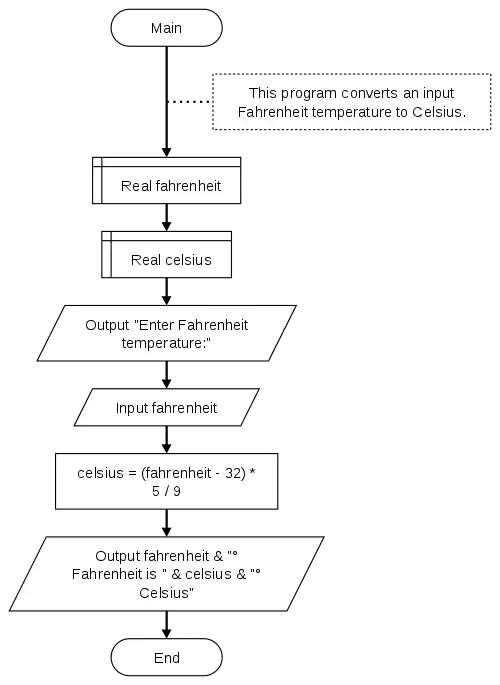< Programming Fundamentals < Variables 
The input–process–output (IPO) model is a widely used approach in systems analysis and software engineering for describing the structure of an information processing program or other process.[1] This activity introduces the IPO model using a simple calculation. This activity will help you understand how to design a simple program.
Objectives
- Understand the input-process-output model.
- Create a simple program using a visual programming environment.
Prerequisites
- Review Creating Flowcharts.
- Review MathsIsFun: Temperature Conversion.
- The formulas for temperature conversion are:
- C = (F - 32) * 5 / 9
- F = C * 9 / 5 + 32
- An operator is a character or symbol used to perform an arithmetic, logical, or bitwise operation on one or more operands.[2]
- String concatenation is the joining of character strings end-to-end.[3]
- An assignment statement sets and/or re-sets the value stored in the storage location(s) denoted by a variable name; in other words, it copies a value into the variable.[4]
Introduction

Input-Process-Output model
Review the flowchart example on the right.
Questions
- What flowcharting symbol is used to indicate the beginning and ending of a program?
- What flowcharting symbol is used to indicate annotations or comments?
- What flowcharting symbol is used to indicate variable declaration?
- What flowcharting symbol is used to indicate input and output?
- What flowcharting symbol is used to indicate a process or calculation?
- What operator is used for addition, subtraction, multiplication, and division?
- What operator is used for assignment?
- What operator is used for string concatenation?
Activity
With a partner, perform the following:
- Using a visual programming language, create a program matching the flowchart on the right.
- Save the program.
- Test the program with known Fahrenheit-Celsius temperature pairs to make sure it works correctly.
- Trade places, so that both partners have an opportunity to "drive" the visual programming environment.
- Copy the program and change it so that it performs the opposite calculation, converting Celsius temperatures to Fahrenheit.
- Save the program.
- Test the program with known Celsius-Fahrenheit temperature pairs to make sure it works correctly.
Applications
- Identify specific steps which must be followed when creating a program using the Input-Process-Output model.
- Discuss your activity experience with your classmates. What surprised you? What have you learned that you can apply to your own school or work environment?
References
This article is issued from Wikiversity. The text is licensed under Creative Commons - Attribution - Sharealike. Additional terms may apply for the media files.